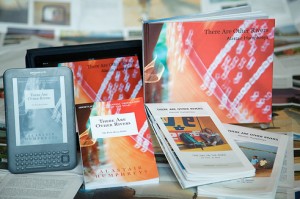by Joanna Penn
I’m really pleased today to bring you an article from my friend and fellow blogger Joanna Penn. Her blog, The Creative Penn is an inspiration to me and thousands of other writers, and it was recently voted, for the second year in a row, one of Write to Done’s Top 10 Blogs for Writers.
Joanna’s new book is Prophecy, the second volume in a series of action-packed thrillers with a religious historical background that began with Pentecost. Today Joanna poses a question that confronts every self-publisher when it comes time to decide in which format their book should be published. Here’s her article.
You might have noticed that ebooks are going mainstream. Amazon shipped millions of Kindles over the holiday period and traditional publishers are reporting increasingly high ebook revenues.
There have also been a number of ‘famous’ self-published authors making it big with ebook sales. John Locke, Amanda Hocking and JA Konrath are the most well known. Increasingly, indie authors are moving to ebook-only releases. So is a print book just a vanity project these days?
What is vanity anyway?
The word vanity is emotive for self-publishers because for years it was associated with the stigma of the vanity press. It smacks of desperate, rejected authors paying huge sums to see their books in print.
 Self-publishing is totally different these days as authors can pay freelancers to do professional design work and then publish their print books with print on demand technology to reach a global audience. Or they can publish an ebook and upload it ready for sale within 24 hours.
Self-publishing is totally different these days as authors can pay freelancers to do professional design work and then publish their print books with print on demand technology to reach a global audience. Or they can publish an ebook and upload it ready for sale within 24 hours.
So I’ll explain vanity from my own perspective, with the acknowledgment that ego is always some part of the need to publish and reach readers.
I self-published my first novel, Pentecost in February 2011 in print and ebook formats. Joel did an amazing job of designing my cover and the internal print book design so that I could have a world-class print book.
I have since sold over 16,000 copies of Pentecost but here’s the issue: approximately 15,200 of those are ebooks and mainly sold on Amazon.
My second novel, Prophecy is now available and I have been trying to decide whether to create a print version. Looking at the sales figures for Pentecost, I decided that I only wanted a print book because of my own vanity. I wanted to give it to my parents and to have it sit on my bookshelf.
But 95% of my readers buy in ebook format and in fact, I read mainly ebooks myself these days, and I never buy fiction in print. With these facts in mind, what should I do?
When is print still a good idea?
We all still love print books. To browse a bookshop and pick out beautiful books with eye-catching covers is the bibliophile’s addiction. We like to own these objects to keep and admire, to read but also to remind us of the knowledge that lies within. Creating a book is a special project that appeals to a deep yearning we have had for many years. So when is print still the best route?
- When the beauty of the finished product matters
This site has some great articles on the importance of font and typography as well as the intricacies of book design which many people care deeply about. The aesthetics of the finished product matter to them.
For some books, the physical look and feel is part of the final product. Books with images, specific layouts and design all require a physical product for the creative project to be fully realized. Children’s books are starting to move into the digital realm but the technology is still immature and physical books still rule.
Recently I interviewed Alastair Humphreys, nominated for National Geographic explorer of the year. He walked across India and created a whole series of versions of his finished book, There Are Other Rivers.
As well as the Kindle and iPad versions, he also created a paperback version, a hardback coffee-table photography book and a full-size, foldable map of his journey with photos and writing. I bought the map because it’s an awesome, original physical print product that can’t be duplicated well in digital format.
Alastair is currently rowing across the Atlantic so no doubt more print adventures are to follow.
- When you have an established distribution method for print
I don’t mean print on demand here. I mean that you have a speaking platform where you can sell print products at the back of the room, or you have bookshops that will sell your print books. Then it’s definitely worth having a print run as you can make money from it.
I made the mistake years ago of doing a small print run of several thousand books without having the means to sell them. The beauty of print on demand is that you hold no stock and upfront costs are negligible, but because of the slightly higher prices, you won’t make as much money as if you do a small print run and then sell physically at a profit.
- If it’s your dream to hold your book in your hand (or you want a copy to give to your Mom!)
If this is vanity, there’s nothing wrong with it and by all means, I believe everyone should have a print book if they want one. It’s within your reach these days with print on demand technology. Recently I helped my niece, 9 year old Anna, publish her first book on Blurb.com. Her pride at the finished product was fantastic and her school put it in the library. Ebooks mean nothing to her so a print book was the only option even if friends and family were the only ones who bought it. Print still stimulates the imagination.
When should you consider ebook only?
At the moment, the highest-selling volume of ebooks is commercial fiction, which people read for the story, not the beauty of the physical book. Straight text novels are easy for the author to publish straight to ebook platforms and can be for sale within 24 hours after the completion of the editing process. This also applies to straight text non-fiction and other books that don’t require formatting and internal design for a polished finished product.
This type of book is also where the most money is to be made from ebooks, or at least that’s what we’ve seen so far.
So what am I doing?
People will say that it’s easy to create a print book on CreateSpace but Joel has shown me that world-class print books need design and care from professionals to be most effective. Also, the sales of my print books can’t justify the cost of pro-design and I’d rather spend the time and effort writing the next in the series. So Prophecy is available in ebook only format for now.
Each person has their own reasons around the publishing decisions they make. Ultimately, it’s up to you. Whether you invest in a beautifully designed print book or publish swiftly in ebook-only format, it’s the creative process that matters, culminating in a finished product that readers enjoy.
Joanna Penn’s latest novel, Prophecy, an ARKANE thriller, is out now in ebook format on Amazon.com and Amazon.co.uk. Follow Joanna on Twitter @thecreativepenn
Photo by quinn.anya



